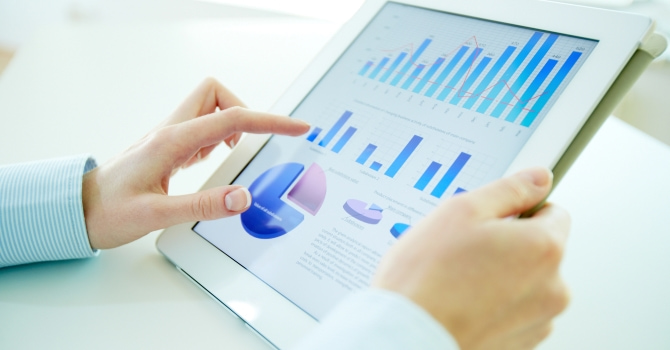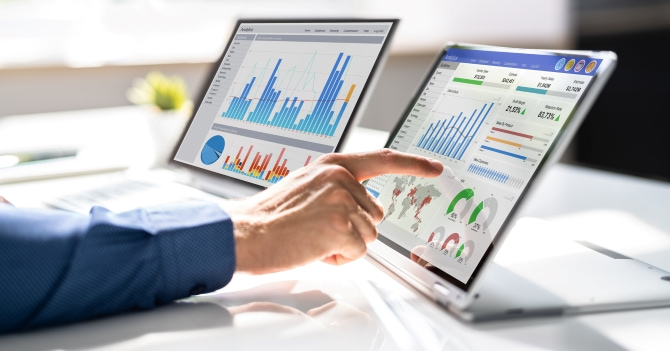A Teacher’s Guide to Learning Analytics in Education
For the last few centuries, we have gained a better understanding of how learning works. However, it’s difficult to adjust our educational systems without knowing how our students respond to different learning strategies. Thankfully, it’s much simpler today to gather that information by using learning analytics.
These days, with the ever-growing popularity of digital learning, it’s become much easier to gather data on students’ performance at school. This data, when analyzed correctly, can help educators improve their courses, offer better student support, and integrate personalized learning.
In this article, we will talk about what learning analytics in education is and how to use it to make informed decisions and improvements.

What Is Learning Analytics?
Learning analytics involves the measurement, collection, analysis, and reporting of data related to learners. As an educator, you can use this data to pinpoint areas of improvement in your learning materials or your students’ performance.
Advantages of Using Learning Analytics in Education
Information is one of the most valuable resources you have as an educator, and this includes learners’ data. By utilizing learning analytics, you can make informed decisions about improving your students’ performance.
With that in mind, let’s talk about the main advantages of analyzing how well your students are performing in your class.
1. Predicting Learners’ Behavior and Performance
One of the key benefits of using education data analytics is measuring and predicting students’ performance. From the data you collect, you can understand how your students interact with the course material and how they might perform on future tests.
Over time, you can offer your students better support by understanding their study habits and the challenges they face while learning.
2. Reducing the Cost of Trial and Error
Another advantage of learning analytics in education is reducing the costs of implementing new learning systems. More often than not, the cost and risk of failure might discourage you from trying new teaching methods.
However, you can minimize this problem by using data analytics. By learning from students’ historical data, you can introduce new teaching methods that are more likely to work for them.
For example, imagine you have two ways to teach your students: video lessons and textbook excerpts. To measure the effectiveness of both methods, you can split your students into two groups. One will only use the textbook, and the other will rely only on the video lessons. Then, you can give both groups tests, assignments, and critical thinking exercises. By comparing their results, you’ll see which teaching method helps your students learn best. Running experiments like these will provide valuable insights that you can use to improve your course.

3. Improving Educators’ Decision-Making Process
From the points above, we can deduce that learner analytics will help you make informed decisions about your education system. Not only will you find the best ways to provide learning resources at the right cost, but you will also be able to optimize the learning experience for your students.
As an example, in education, it’s common to acquire new technology or equipment to use in class. In such cases, conducting learning analyses using a small sample of those technologies can help you decide whether the full investment is worth the cost.
Disadvantages of Using Learner Analytics in Education
Like any other educational technology, learning analytics presents certain challenges that need to be addressed. While their effects are mild on a small database of student data, you will start running into these issues more frequently with a large database.
1. Risk of Data Security and Privacy Concerns
A key concern regarding data analytics in general is the risk of data being leaked or mishandled due to insufficient security. This problem naturally extends to learning analytics as well, where analysts may have access to sensitive or personally identifiable information, like students’ full contact information.
Therefore, educators must use secure software and encrypted servers whenever possible to reduce the likelihood of the data being hacked. Moreover, it’s a good practice to inform students’ legal guardians about how the collected data will be used so they can consent to the analytics process.
2. Time-Consuming Process that Requires Analytical Skills
While computer programs are quite useful, all they can do is present you with the data and charts that you requested. Therefore, you must have the necessary analytical skills and the time in order to understand data trends and make decisions accordingly.
If you don’t have the time or the needed skills to analyze the data yourself, you can hire an analyst to do it for you. If that’s not an option, then you can use adaptive learning platforms, which use AI to analyze the learners’ data and provide recommendations based on the reports.
3. Expensive Storage Requirements for Large Sets of Data
The longer a learning analytics system operates, the larger the volume of data it collects. All this data needs to be stored somewhere, whether it’s on the cloud or on a local server. If your software is handling data on hundreds of students, you will need a storage solution that you can access easily.

The 4 Methodologies of Learning Analytics
Using different analytics methodologies will give you different results. So, it’s important to know and understand the four main types and the kinds of data you use with each of them.
There are four main methodologies used in learning analytics:
- Descriptive: Descriptive analytics involves analyzing students’ past actions and their feedback on the course to look for any trends or patterns.
- Diagnostic: Under this methodology, you would analyze the major factors that affect students’ performance and potential, such as the time they spend preparing for classes.
- Predictive: Through a predictive approach, you can use historical data to predict future patterns, which helps you enhance your teaching methods.
- Prescriptive: This methodology combines descriptive and predictive approaches to propose recommended actions and plans. You can then apply these plans to any part of the learning process.
Types of Data Collected for Learning Analytics
Now that you know how to use learning analytics, you might be wondering which types of data you need to collect. Is every piece of information useful, or does some data take priority over others?
As it turns out, educators have found certain types of data to be great sources of valuable information. Some of these types include:
- What location (classroom, office, home, etc.) students are learning from: This can help you measure the efficiency of remote vs in-class learning.
- What device(s) they’re using: For example, some students prefer learning from their phones or tablets, while others prefer a laptop or desktop. These preferences can place limits on the types of content you can create.
- Which time of the day they log in to the platform: Analyzing this data can help you strategically set assignment deadlines and plan live sessions more efficiently.
- How much progress they’ve made in the course: By comparing students’ progress, you can adjust the length and difficulty of your course to fit their needs.
- Which type(s) of learning materials (video, text, etc.) they use most: Some students focus better on different types of lessons, such as video or text.
- How much time they take to complete assessments: This data will help you set quiz deadlines and durations.
- How many mistakes they make compared to how many questions they answer correctly: This ratio can give you a basic idea of how well a student understands a particular lesson.
- The types of mistakes they make in quizzes and exercises. Mistakes might result from students misreading the question, forgetting the answer, or not fully understanding a lesson. Knowing the nature of these mistakes can help you pinpoint exactly what your students are struggling with.
- How much they participate in live sessions, workshops, etc: You can use this data to measure students’ engagement, confidence, and curiosity.
- Whether or not they make use of any additional resources provided by the course: This data can tell you if extra materials should be added to the course or remain optional.
- How much time they take to complete the course: You can use this data to adjust the length and difficulty of your course for future students.
- How they respond on feedback forms and surveys: Using feedback forms allows you to ask more specific questions about your students’ experiences.

Applications of Learning Analytics in Education
It’s time to look at how you, as an educator, can use learning analytics in your own institution. How you interpret and use the resulting information will depend on your teaching goals and your students’ needs.
1. Improving and Personalizing Educational Courses
As an educator, you’re always looking for ways to improve your courses and help your students improve. To do so, it’s crucial to learn how your students perform best, which you can do using student performance reports.
2. Offering Better Feedback for Students
Due to time and money constraints, it can be hard to gain a good understanding of each student’s needs without advanced data collection technology. Some may need gentle feedback on their work (positive reinforcement). Others prefer constructive criticism and detailed directions to fix their mistakes.
This is where learning analytics comes in. By collecting relevant data, you can determine the best ways of providing feedback and support to your students. In other words, you can help struggling students improve and motivate others to challenge themselves. Plus, this new support network becomes an opportunity for them to start thinking more critically about their work.
3. Assigning the Right Learning Material for Students at Different Levels
Not all students learn the same way. Some learners focus better when watching visual media such as video, for example. Others might prefer listening to lectures while reading their textbook. In other words, your students might have vastly different needs when it comes to learning new information.
By using learning analytics, you can quickly identify these needs for each student. After that, you can provide auditory, visual, and hands-on learners with their preferred medium and boost their chances of success.
You can also take a similar approach when it comes to the difficulty level of your course material. If a few of your students are struggling to keep up, you can give them less advanced material to work on. On the other hand, other students might find the current level too easy, so you can give them high-level content to challenge them.

How to Use Kotobee Author in Learning Analytics
Kotobee Author offers useful tools for tracking learning analytics, making it easier to continuously update your learning material. By integrating them with Kotobee, you gain access to advanced analytics reports about your students.
Let’s go through each of these analytics tools and how you can use them in Kotobee Author.
1. Google Analytics
You can integrate Google Analytics into Kotobee Author to track how students interact with your ebook. Some of the data you can collect includes:
- The number of students accessing the ebook.
- How long they spend on different chapters or sections.
- The number of clicks on interactive elements such as quizzes, videos, and links.
2. SCORM
Kotobee supports SCORM-compliant ebook creation, making it compatible with learning management systems like Moodle.
SCORM allows tracking user activities such as:
- Students’ quiz results.
- The amount of time they spend on a course.
- How many learning modules they complete.
3. xAPI
Kotobee Author also integrates with xAPI (formerly known as Tin Can API), a more advanced analytics standard than SCORM. With xAPI, you can track students’ activities inside the ebook and also how they interact with external related materials. For example, you can see when a student watches a video, completes a quiz, or reads articles on the same subject.
As a result, xAPI gives you a more comprehensive look at your students’ learning journey.
4. LTI (Learning Tools Interoperability)
Kotobee Author supports LTI as well, seamlessly connecting your ebook and external learning platforms or tools. This allows for real-time analytics tracking through an LMS, along with the ability to push learning outcomes, grades, and progress reports from external tools into a central LMS system.
Final Thoughts
As educational methods evolve, so do students’ educational needs. To keep up, you can use learning analytics and understand how they interact with your course. From there, you can offer a better educational experience for them at a fraction of the cost and risk.
Have you used learning analytics in your own courses? Share with us your experiences and your students’ feedback in the comment section below.
.
Read More
Personalized Learning: What Is It and Is it Feasible?
Enhancing Student Engagement: Using Interactive Ebooks for Effective Learning
















